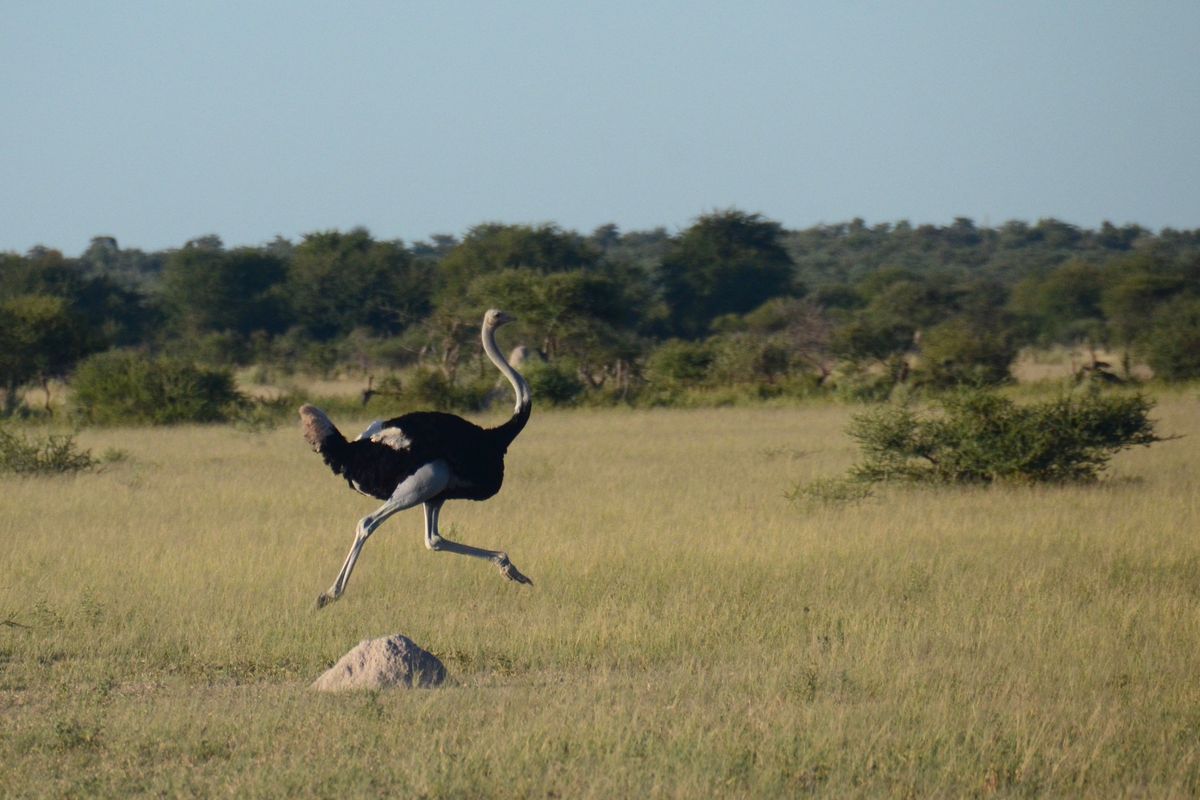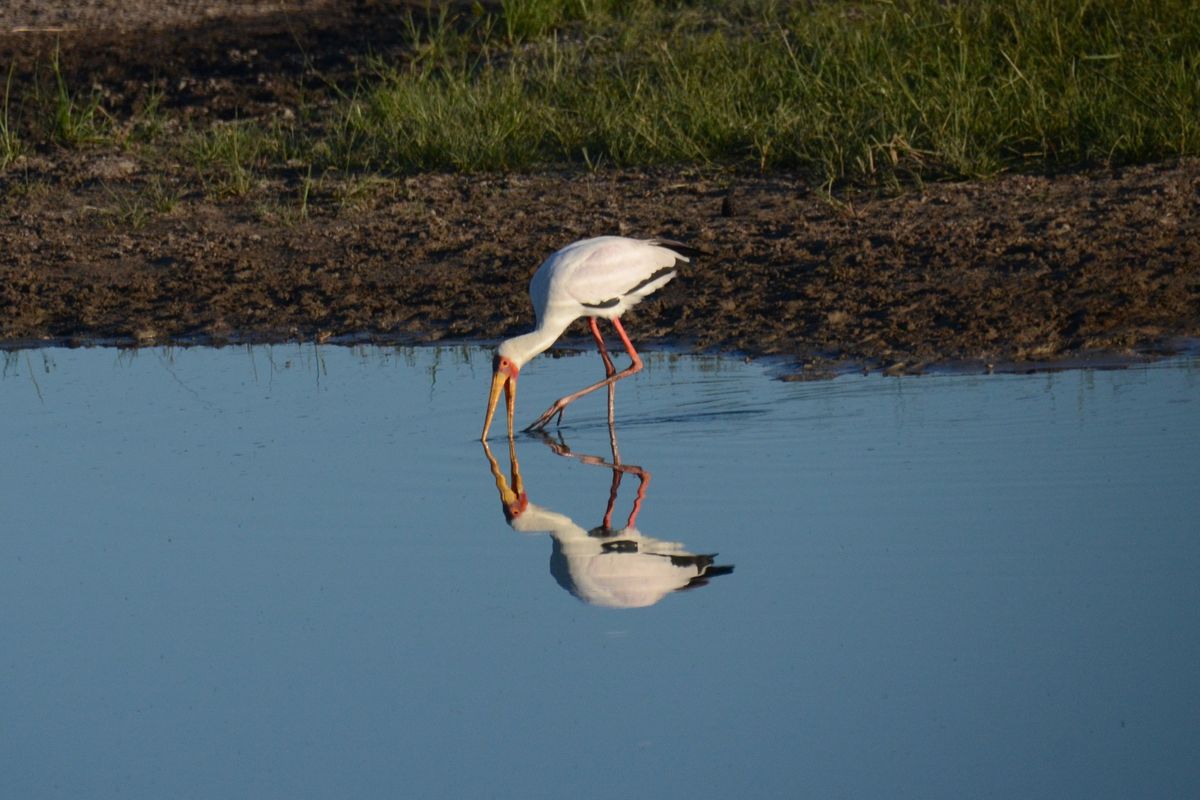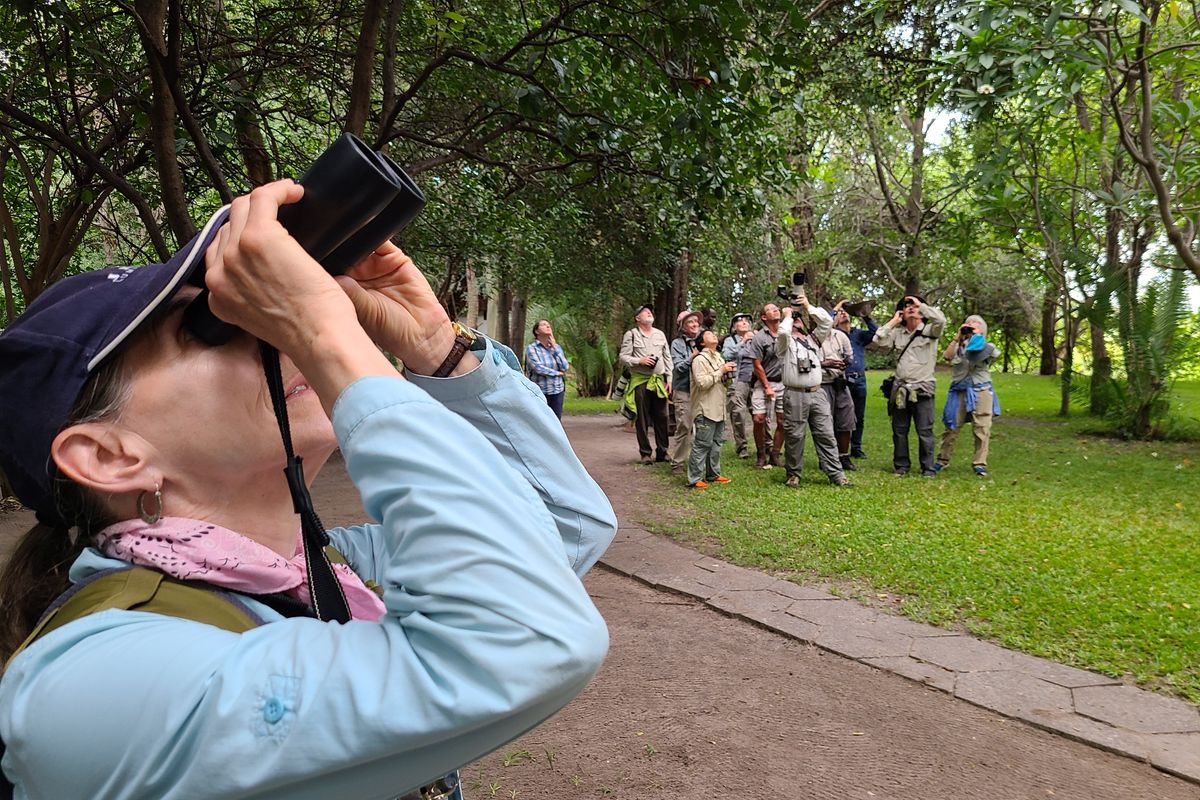Tickled by feathers: Neophyte finds niche among hot-shot birders in Africa
The yellow-billed stork wades through the water with a partially open bill that snaps shut with a lightning-fast reflex when it senses contact with prey. (Rich Landers/For The Spokesman-Review)Buy a print of this photo
When the lions left a kill, circling vultures converged.
When the elephants hid from the sun, the focus shifted to 12 species of larks to identify.
At sunset, owls materialized.
A birdwatcher’s binoculars have little down time in the African bush.
Our group of 11, with the help of two expert guides (and no help from me), recorded a whopping 310 bird species during a 22-day wildlife safari to several national parks and preserves in northern Botswana.
For comparison, the Big Year record for the entire state of Washington is 376 species set by Will Brooks of Tacoma in 2021. Idaho’s Big Year record is 319 by Carter Strope of Boise in 2020.
Our gang had four wildlife professionals, including two PhDs in ornithology, another who did post-graduate work on spotted owls, and other birding hot shots who have checked off more birds on their life-lists than I have accumulated on my life-list of sins.
We’re talking big numbers.
Guides Johnny Ramsden and Pat Malatsi of Royale Wilderness (www.royalewilderness.com) injected birding into every moment when we weren’t locked in on leopards, giraffes, hippos and other leading safari attractions.
Indeed, sightings of flapping, squawking birds often tipped us off to prized sightings of, say, a python or black mamba hiding in a tree.
It was a bit discomfiting to be embedded in the major leagues of birding while lacking the qualifications to even be their bat boy.
Yet the enthusiasm of the feathers-first group was admirable and infectious.
Search for clues
Being a relative novice in “a gape of birders” (I made up that collective term, and it’s dead-on) allowed me to observe how tuned in they are to nature in a global way.
The serious birders weren’t just interested in birds, but also eager to learn about the grasses birds inhabit, what types of trees on which they perch and which insects they eat.
Their eyes locked-in on nanoscopic clues of color, movement or shape that gave away the location of an otherwise well-camouflaged bird in the distance.
Their ears perked up to detect species by their songs and calls.
As much as the gang and our guides already knew, they were constantly referring to field guides and iPads with birding apps for more information and verification.
They were keen on seeing apex predators such as leopards, but they were giddy one afternoon in the Okavango Delta after checking off the secretive Pel’s fishing owl.
They boated an hour up the river specifically to find a lesser jacana, which has disproportionately long toes that allow it to stroll on lily pads and slightly submerged aquatic vegetation.
Indeed, it was a religious experience. Since they appear to walk on water, jacanas are sometimes called “Jesus birds.”
One evening during our brief stay at Drotsky’s Cabins on the Okavango River, Malatsi, the guide, brought to happy hour his copy of the regional ornithological Bible, “Roberts Birds of Southern Africa.”
After much discussion about the contents, he picked up the massive book, pressed it to his chest and gave all 1,296 pages a big hug.
“I won’t be truly happy until I know everything in this book,” Malatsi said.
Focusing the search
To avoid being overwhelmed among such aficionados, I narrowed my scope.
I focused on the gift of having three weeks to simply learn something new about birds every day. I wasn’t going to stress out with the unreasonable goal, for me, of knowing it all.
Rather than check a bunch of species on a list, I set out to know something new about a fraction of the unfamiliar cast of birds I had traveled halfway around the planet to experience.
I started in the most basic way, bypassing the difficult-to-identify little brown birds and tuned in to the eye-catching species like the paradise fly catcher with its long rusty orange tailfeathers.
I would try to connect similarities between African birds and familiar species from home.
For instance, the crowned lapwing ran and fed on the ground similar to our killdeer, and the kori bustard, Botswana’s national bird, is a ground roamer about the size of our wild turkey.
Then I started paying more attention to what distinguished individual species.
For instance, Burchell’s sand grouse brings water to its brood after wading into waterholes and capturing droplets in its breast feathers.
The blacksmith lapwing’s name is derived from its “tink, tink, tink’” alarm call, which sounds like a blacksmith’s hammer striking an anvil.
Red-billed quelea, Ramsden said, are the most abundant wild bird on earth. The sparrow-sized songbird, of the weaver family, congregates in huge numbers that can destroy crops.
The “most photographed bird in southern Africa,” Ramsden said, is the lilac-breasted roller.
This robin-size bird is colorful, common and tolerant of humans: the perfect subject for the fledgling bird photographer.
It’s one of the “roller” species that swoops into aerial dives and rolls like an airplane stunt flyer – a feat we were able to observe.
With such keen flying skills, it’s no surprise that the rollers mate on the wing.
Fastest nonflying bird
Even a neophyte birder has no trouble identifying the ostrich. The largest bird in the world may be flightless but it nearly leaves a vapor trail when it runs.
It weighs 250 to 300 pounds and stands up to 9 feet tall.
Guidebooks say those long legs – each with two clawed toes for traction and for inflicting great harm when they kick – can cover 10 feet in a stride and propel the ostrich up to 35 mph – faster than any other bird.
Ramsden collected a couple of shed feathers for a closer look.
Ostrich feathers are loose, soft, smooth, and often referred to as a plume.
They don’t hook together the way most feathers do, giving ostriches a “shaggy” look.
In the 18th century, ostrich feathers were so popular in ladies’ fashion that the birds disappeared from North Africa.
If not for ostrich farming, which began in 1838, the world’s largest bird could have become extinct.
I had several opportunities to identify birds dealing with current conservation concerns.
Twice we watched families of southern ground hornbills, each time with a male and female with one prized chick.
These birds, which weigh up to 10 pounds, have a reproductive schedule that leaves little margin for survival in an ever-more-crowded world affected by climate change.
The parents guard and provide food for their offspring, which remain with the pair for up to three years.
Although they can live 50-60 years, they may not breed until they are about 10. On average, about one of their chicks survives to adulthood every nine years, Ramsden said.
The bee-eaters, which include about 30 species, are eye-catching for their vivid colors as well as the conspicuous way they deal with a bee when they catch it in the air.
They land on a branch and whack the bee or wasp on wood, or even a thorn, to expel the stinger and some of the venom. They then flip the insect into the air and gulp it down.
Some birds are fun to watch because of their link to animals, like the white cattle egrets that follow hoofed animals to eat the bugs loosened from the ground by their feet.
The oxpecker is even bolder, perching on the backs or heads of large mammals to feed on the ticks and other bugs infesting their hides.
The pale chanting goshawk sometimes follows honey badgers, mongooses and other small predators on the chance they might flush prey the bird can catch.
Lessons for home
Looking into the “finder” names that precede bird titles can sometimes make a lasting impression.
I learned this after noticing the pink eyelids that helped me verify my first sighting of a Verreaux’s eagle-owl, the largest African owl. (It’s bigger than the great-horned owl common around Spokane).
The name owes to a French naturalist and taxidermist Jules Verreaux, who reportedly identified the bird as a teenager during a multiyear family business trip to Africa.
But Verreaux’s fame later became notorious after a funeral in 1830 when he stole the body of a young African warrior in what is now Botswana. He skinned it and stuffed it with some of its bones so it could be displayed in museums.
Learning details about birds can be fun and satisfying as well as sobering, I learned.
A three-week safari is a rare privilege and opportunity to wake each morning and know that you’re soon going to see or hear another bird species that you’ve never experienced before in the wild.
It would be a pity to return home from a trip like this without new motivation to go out each day and look for birds that you have experienced all your life and never really noticed.





